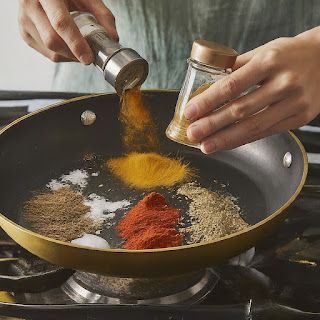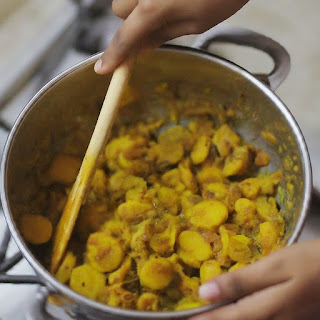Arbi Ki Sabji Recipe| A Delicious Indian Taro
Root Dish
Arbi Ki Sabji(Taro Root )
Arbi (Taro Root)ki Sabji is a flavorful, traditional Indian vegetable dish made from taro root (known as Arbi in Hindi). This mildly spiced, dry curry is popular in many North Indian households and is often served with chapati, puri, or rice. Arbi (Taro) is a starchy root vegetable that, when cooked with the right blend of spices, becomes a delicious, satisfying dish. Whether you're preparing it for lunch, dinner, or a festive occasion, Arbi ki sabji is quick and easy to make, and it packs in both flavor and nutrition.
In this step-by-step recipe guide, we’ll cover everything from the ingredients to the detailed preparation process. Plus, we’ll include tips for perfecting the dish and ways to make variations to suit different tastes.
Ingredients for Arbi Ki Sabji
Before we dive into the cooking process, here’s a list of ingredients you’ll need for this tasty dish.
Main Ingredients:
- 500g arbi (taro root)
- 2 tablespoons mustard oil (or any cooking oil)
- 1 teaspoon cumin seeds (jeera)
- 1 teaspoon ajwain (carom seeds)
- 2 green chilies (slit)
- 1 teaspoon ginger paste
- 1/2 teaspoon turmeric powder (haldi)
- 1 teaspoon coriander powder (dhania)
- 1/2 teaspoon cumin powder
- 1/2 teaspoon garam masala
- 1/2 teaspoon red chili powder
- Salt to taste
- 2 tablespoons fresh coriander leaves (for garnish)
Optional Ingredients:
- A pinch of amchur (dry mango powder) or lemon juice for tanginess
- 1 tablespoon sesame seeds for extra crunch
Tip: Using mustard oil gives Arbi ki sabji its authentic North Indian flavor, but you can substitute it with any cooking oil if needed.
Step-by-Step Arbi Ki Sabji Recipe
Let’s get started with this simple recipe.
Follow these steps carefully, and you’ll have a delicious Arbi ki Sabji ready in no time.
Step 1: Boiling the Arbi
Arbi(Taro Root )
- Start by thoroughly washing the Arbi under running water to remove dirt.
- Place the Arbi in a pressure cooker or a large pot and add enough water to cover the Arbi.
- Boil it for about 3-4 whistles in the pressure cooker (or 15-20 minutes in a pot) until it’s tender but not too soft. You want it firm enough to hold its shape.
- Let it cool down slightly, then peel the skin and slice the Arbi into medium-sized pieces.
Tip: Be careful not to overcook the arbi, as it can become mushy. It should be soft but hold its shape when cut.
Step 2: Preparing the Tempering
- In a heavy-bottomed pan, heat 2 tablespoons of mustard oil until it starts to smoke slightly. This helps to reduce its pungency.
- Add cumin seeds and ajwain (carom seeds). Let them sizzle for a few seconds until they release their aroma.
- Add green chilies and ginger paste. Sauté for 30 seconds until fragrant.
Tip: Ajwain (Carom Seeds) not only enhances the flavor but also helps with digestion, which is perfect for a root vegetable like Arbi.
Step 3: Adding the Spices
- Lower the heat and add turmeric powder, coriander powder, cumin powder, and red chili powder.
- Stir the spices quickly to avoid burning and cook them for about a minute.
Tip: If the spices stick to the pan, add a tablespoon of water to prevent them from burning.
Step 4: Cooking the Arbi
- Now, add the boiled and sliced Arbi into the pan. Gently toss it with the spices to coat each piece evenly.
- Cook on low-medium heat for 10-15 minutes, stirring occasionally to ensure the Arbi becomes slightly crispy and well-coated with the spices.
- Add salt and garam masala toward the end of the cooking process.
Tip: If you want your Arbi to be extra crispy, you can shallow fry the Arbi slices before adding them to the tempering.
Step 5: Garnishing
- Once the Arbi is cooked to your desired crispness, turn off the heat.
- Garnish with fresh coriander leaves and, if you like a tangy flavor, sprinkle a little amchur powder or squeeze some fresh lemon juice over the top.
Tips for Making Perfect Arbi(Taro Root ) Ki Sabji
1. Avoid Overcooking the Arbi
When boiling Arbi, make sure it’s just tender. Overboiling can make the vegetable mushy and ruin the texture of the dish.
2. Mustard Oil for Authenticity
Mustard oil gives arbi ki sabji a distinctive flavor. However, if you're not used to its taste, you can switch to vegetable oil or sunflower oil.
3. Add Tanginess with Amchur
A pinch of amchur (dry mango powder) or a squeeze of lemon adds a tangy twist that enhances the flavors of the dish. If you prefer a milder flavor, you can skip this step.
Variations of Arbi Ki Sabji
Arbi ki sabji can be made in various ways.
Here are a few popular variations you can try:
1. Arbi Masala
For a more gravy-based dish, add a tomato-onion masala base to the Arbi. This version is great for serving with rice or rotis.
2. Arbi Fry
For a crunchy snack, slice boiled Arbi and deep fry it until golden brown. Sprinkle some chaat masala for an instant savory snack.
3. Arbi with Yogurt
To create a richer dish, add a tablespoon of yogurt to the arbi after sautéing the spices. The yogurt gives a creamy texture and adds a slight tang to the dish.
Storing and Reheating Arbi Ki Sabji
Storing Arbi Ki Sabji
Arbi ki sabji can be stored in an airtight container in the refrigerator for up to 2 days. The flavors actually get better with time as the spices are absorbed by the arbi.
Reheating Arbi Ki Sabji
To reheat, simply warm the sabji in a pan over medium heat or microwave it for a few minutes. If it feels too dry, add a splash of water before reheating to restore its texture.
Nutritional Information:
- Calories: 200 per serving
- Protein: 4 grams per serving
- Fat: 10 grams per serving
- Carbohydrates: 25 grams per serving
- Fiber: 5 grams per serving
Health Benefits of Arbi (Taro Root)
1. Rich in Fiber
Taro root is high in dietary fiber, which aids digestion and promotes gut health.
2. A Good Source of Carbohydrates
Arbi is a great energy booster thanks to its high carbohydrate content, making it a perfect addition to your diet, especially when you need energy for physical activities.
3. Contains Essential Nutrients
Taro root is packed with nutrients like potassium, magnesium, and vitamins C and E, which are beneficial for heart health and overall well-being.
Serving Suggestions
Best Accompaniments
Arbi ki sabji goes well with chapati, puri, or paratha. It’s a great side dish for any Indian meal and pairs beautifully with yogurt or pickle.
Serving for Festive Occasions
If you’re preparing this for a festive meal, serve it alongside a lentil dish like dal or rajma, and include rice or pulao for a complete meal.
Common Mistakes to Avoid
1. Overcooking Arbi
Overcooking will result in mushy Arbi that loses its shape and becomes difficult to work with.
2. Using Too Much Oil
Arbi can absorb oil easily, so be careful not to use too much. Stick to the recommended amount for the best texture and flavor.
3. Burning the Spices
When frying the spices, keep the heat on medium-low. Burnt spices can give the dish a bitter taste, so add a splash of water if needed to prevent burning.
Conclusion
Arbi (Taro Root) ki Sabji is a simple yet flavorful dish that brings out the earthy taste of taro root combined with aromatic Indian spices. With its easy preparation and delicious taste, it’s no wonder this dish is a favorite in many households. Whether you serve it with chapati, rice, or as part of a festive thali, arbi ki sabji is sure to be a crowd-pleaser. Now that you know the recipe and some helpful tips, it’s time to give it a try and bring a taste of traditional Indian cooking to your kitchen.
FAQs
1. Can I make arbi ki sabji without mustard oil?
Yes, you can use any vegetable oil if mustard oil isn’t available or if you don’t like its strong flavor.
2. How do I prevent arbi from becoming slimy?
Make sure to boil the Arbi just until tender and fry it well in oil to prevent any sliminess.
3. Can I freeze arbi ki sabji?
It’s not recommended to freeze Arbi ki sabji as the texture of taro root may change after freezing. It’s best eaten fresh or stored in the fridge for up to 2 days.
4. Is arbi healthy?
Yes, Arbi is a nutritious root vegetable rich in fiber, vitamins, and essential minerals, making it a healthy addition to your diet.
5. Can I make Arbi ki sabji spicy?
Absolutely! You can increase the amount of green chilies or add more red chili powder if you prefer a spicier version.

.png)






.png)
.png)
.png)
.png)
